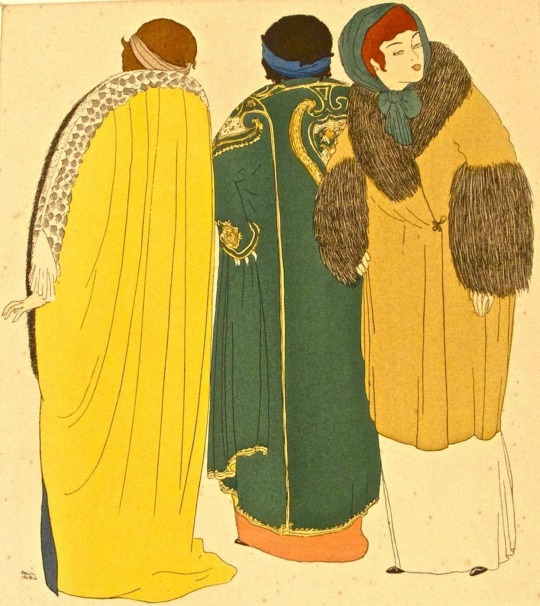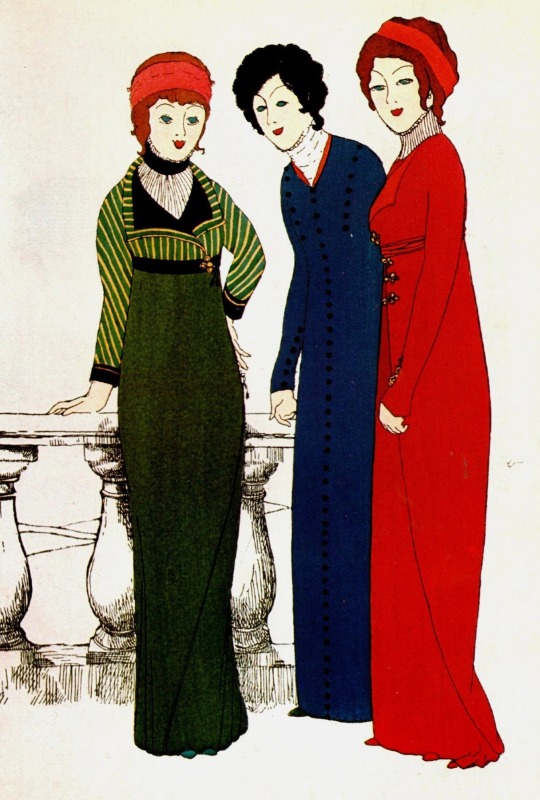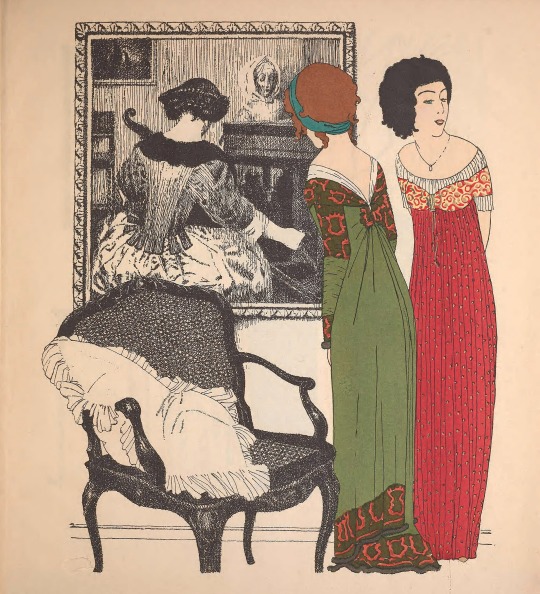#Paul Iribe
Photo
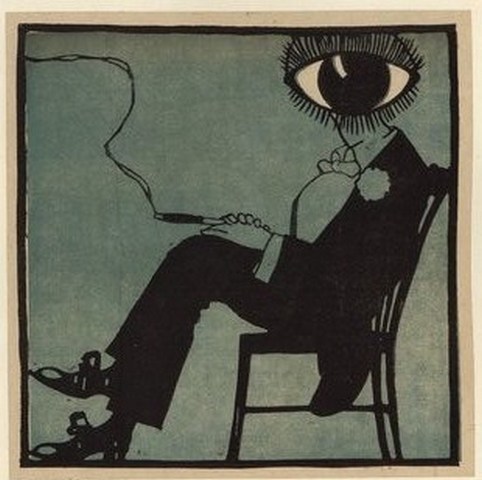
Paul Iribe, Témoin_oeil, 1920s
832 notes
·
View notes
Photo

1912 Paul Iribe, Commode. Mahogany and tulip, interior light mahogany, top slate cladding green tinted green, ebony buttons, ebony base and carved garlands. Art Nouveau.
This commode was one of Paul Iribe’s furniture designs for Jacques Doucet’s apartment at 46, Avenue du Bois in Paris, where he lived from 1913 to 1928. (x)
101 notes
·
View notes
Text

Paul Iribe
Voici La Chambre D'Enfants, circa 1931
12 notes
·
View notes
Text
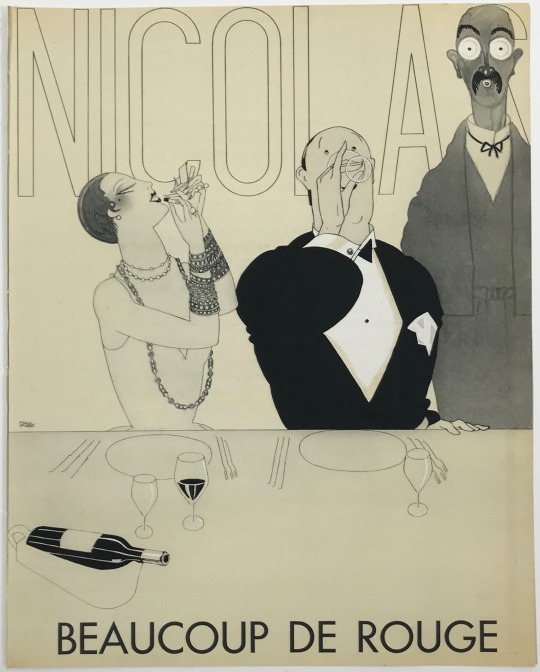
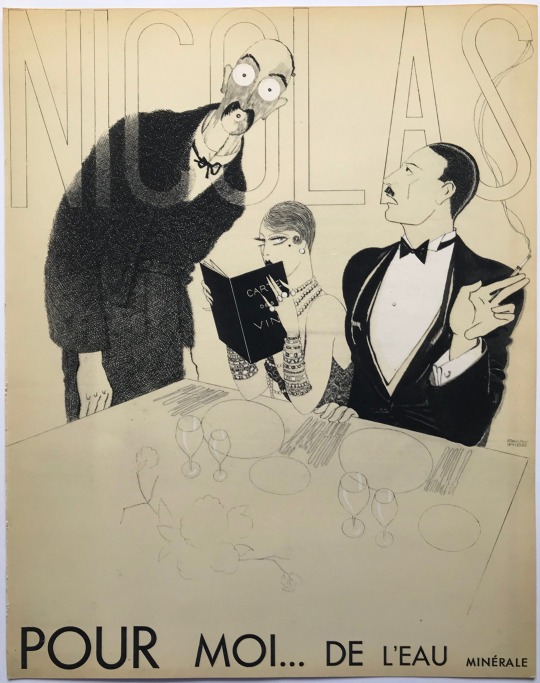



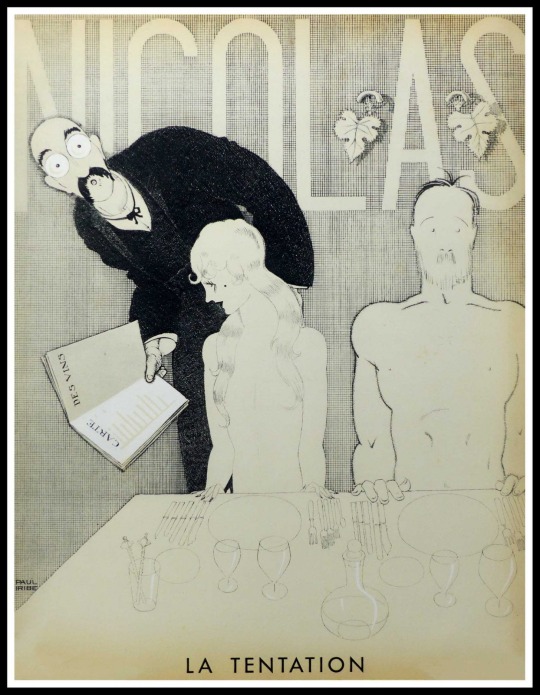
Paul Iribe (1883-1935) for “Nicolas” winery (circa 1920s)
I love the saucer eyes on the waiters. It’s a theme. I’m guessing they’re plastered.
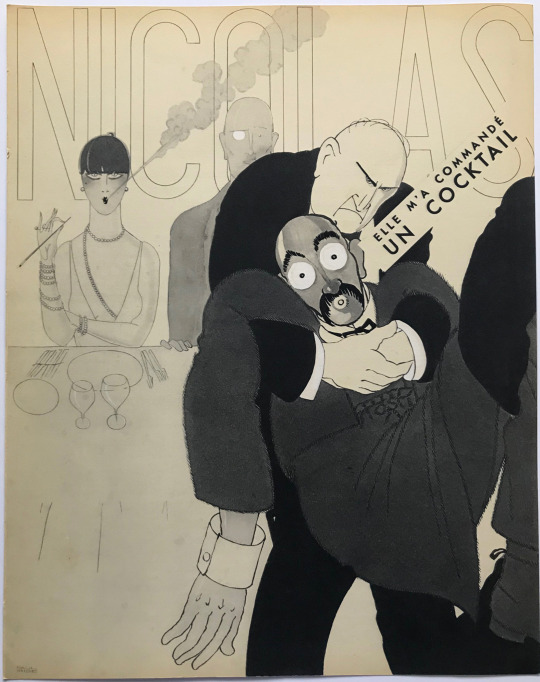
11 notes
·
View notes
Text

1908 Les robes de Paul Poiret by Paul Iribe vii (Sotheby's - 6May22 auction Karl Lagerfeld’s Estate Online III Lot 338). From their Web site; sized to screen 2505X2800.
#1908 fashion#1900s fashion#Belle Époque fashion#Edwardian fashion#head band#off-shoulder neckline#chemise#scoop neckline#Empire neckline#Poiret#Paul Iribe#Karl Lagerfeld#Neo-Directoire style
5 notes
·
View notes
Text
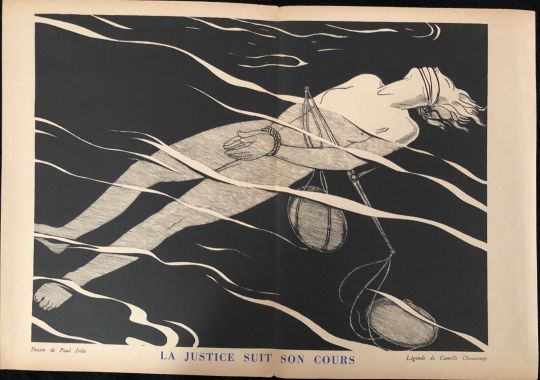
Justice takes its course, illustrated by Paul Iribe for the newspaper Parlons français, 1934.
7 notes
·
View notes
Text

Paul Iribe (1883-1935)
«La justice suit son cours», caricature du système de justice, tirée de «Parlons français» publié par Floury. 1934
17 notes
·
View notes
Photo

Tissus Art Deco en France
Alain-René Hardy
Editions Langlaude , Paris 2011, 255 pages, 310 reproductions en couleurs
euro 60,00*
email if you want to buy :[email protected]
Histoire et évolution technique et esthétique du tissu de 1910 à 1945
Période d'agitation extrême - politique, sociale, culturelle et artistique -, l'Entre-deux-guerres est aussi un moment de création intense dans tous les domaines. À la suite des arts plastiques, les arts décoratifs, dynamisés par l'Exposition de 1925, poursuivent un renouvellement qui va à terme bouleverser le cadre de vie de toute une génération. Tendance bourgeoise, élitiste, à la Ruhlmann, ou aspiration fonctionnaliste, plus démocratique, dans la mouvance de Le Corbusier, le décor intérieur et la mode connaissent des mutations radicales reflétées par le tissu qui y joue un rôle fondamental. C'est à sa découverte que nous invite ici l'auteur, au travers des collections de musées, des archives de fabricants, des vestiges familiaux; au carrefour historique où coexistent, déjà et encore, la soie des canuts et la rayonne de Rhône-Poulenc, les planches en poirier gravées à la main et les énormes rotatives à 24 cylindres, l'indigo et la garance avec l'aniline et l'alizarine, l'artisanat et l'industrie, en un mot, la tradition et le progrès. Tour à tour somptueuse ou minimale, luxueusement fleurie ou tenue dans un simple arrangement élaboré de formes et de couleurs, atemporelle ou célébrant à l'envi les conquêtes de la vie moderne, voire l'actualité, une création textile riche et complexe, contradictoire même, se révèle à nous page après page, portant témoignage irréfutable que le tissu fut un vecteur privilégié des styles Art Déco.
(art deco, annees 25, annees 30, 1925, 1930, annees folles, textiles, tissues d’ameublement, , George #Barbier, #Brunelleschi, Georges #Lepape, Raoul #Dufy, Paul #Iribe,#Sue&Mare, #Fabius, Andre #Groult, , Emile-Alain #Seguy, Jacques-Emile #Ruhlmann, Paul #Poiret, Edouard #Benedictus, Alberto Lorenzi, Madeleine #Vionnet, Callot Soeurs,De Sonia Delaunay, #Verneuil, #Chanel, Paule Marrot, Jean #Lurcat, Elsa #Schiaparelli,
orders to: [email protected]
twitter: @fashionbooksmi
flickr: fashionbooksmilano
instagram: fashionbooksmilano
tumblr: fashionbooksmilano
8 notes
·
View notes
Photo



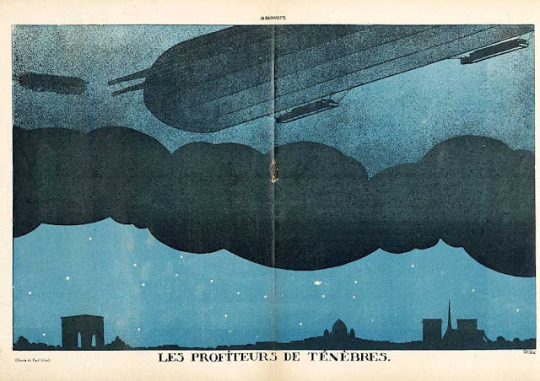

Paul Iribe
La Ba Onette
185 notes
·
View notes
Photo

1914 The “Nautile” chair designed by Paul Iribe. From Art Nouveau Around the World, FB.
360 notes
·
View notes
Text
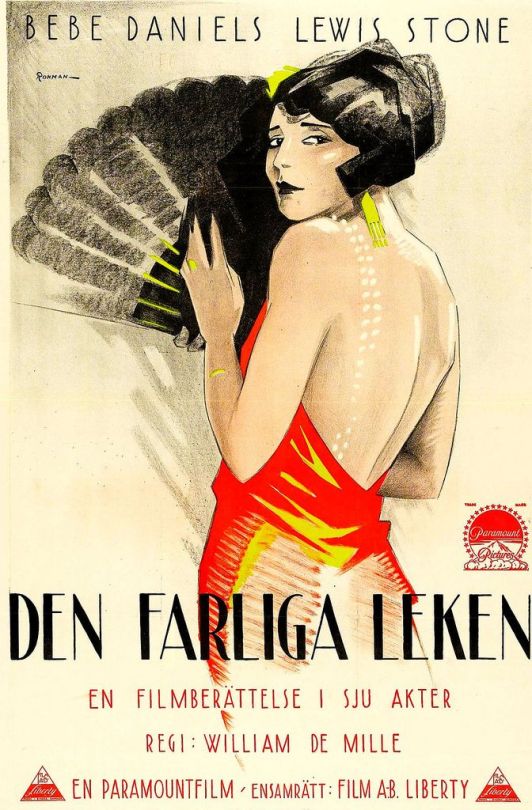


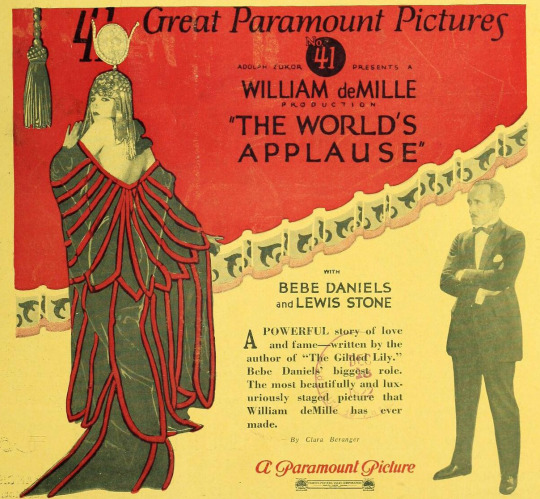
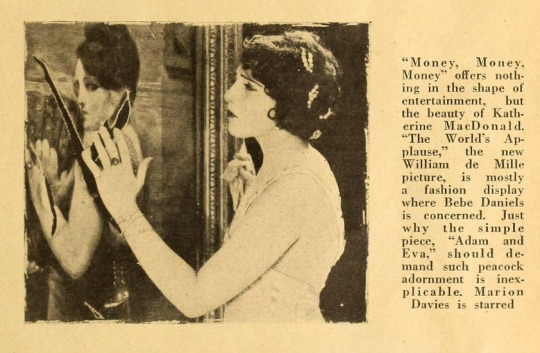


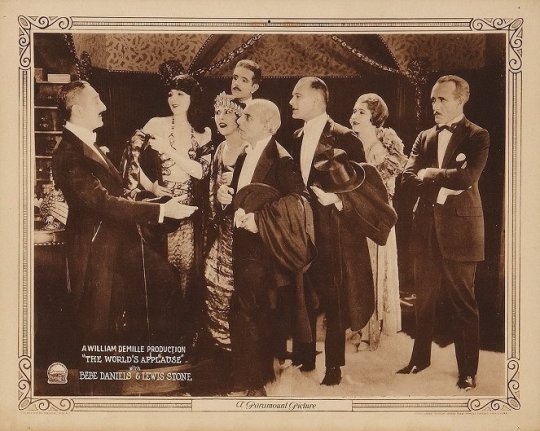
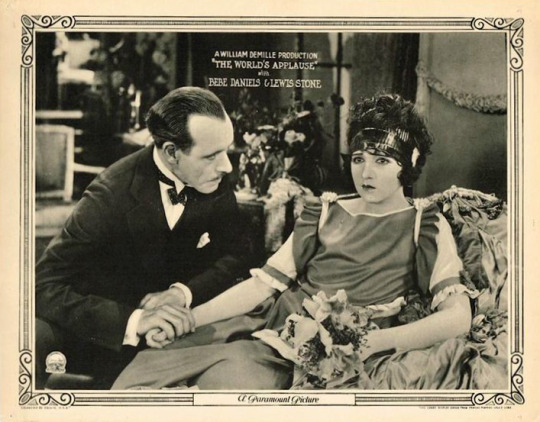
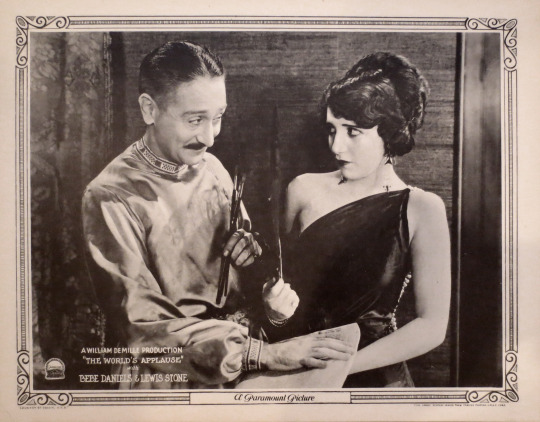
Lost, but Not Forgotten: The World’s Applause (1923)
Direction: William C. de Mille
Scenario & Titles: Clara Beranger (more about Beranger at the Women Film Pioneers Project)
Camera: L. Guy Wilky
Sets & Costumes: Paul Iribe
Studio: Famous Players-Lasky (production) & Paramount (distribution)
Performers: Bebe Daniels, Lewis Stone, Kathlyn Williams, Adolphe Menjou, Brandon Hurst, Bernice Frank, Maym Kelso, George Kuwa, James Neill
Status: presumed entirely lost
Synopsis (synthesized from magazine summaries of the plot):
Corinne D’Alys (Bebe Daniels), f.k.a. Cora Daly, is a theater star who has “taken the Rialto by storm.” Unfortunately, Corinne also has a desperate hunger for publicity. Her manager, John Elliott (Lewis Stone), who also happens to be in love with her, advises her to be more sensible about her career. A famous artist, Robert Townsend (Adolphe Menjou), has become enamored with Corinne, and wants to paint her portrait. Despite John’s warning that Robert wishes only to “see more of her,” Corinne sits for the portrait.
Robert plans on throwing a party to celebrate finishing the painting but declines to invite his wife, Elsa Townsend (Kathlyn Williams). Elsa comes to her husband’s studio anyway and finds the portrait and a pearl headdress that Robert is going to gift to Corinne. In a jealous rage, Elsa takes a knife to the painting and then to her husband—fatally stabbing him. Elsa also happens to be John’s sister and she calls him in a panic to help her. John arrives at the studio in secret and helps Elsa escape the scene. Meanwhile, Corinne and the guests begin to wonder where their host is, and Corinne then finds the body of the painter.
John convinces the police that Corinne is innocent. Corinne leaves town to avoid the storm. Unfortunately, John then becomes the primary suspect, as he had a notable fight with his brother-in-law months prior. When John is arrested, Corinne returns and confesses to Elsa that she feels morally responsible for Robert’s murder. Elsa then confesses to committing the murder herself. It’s implied that Elsa commits suicide via “the watery route.”
Now that both John and Corinne have been cleared of suspicion, they are free to marry and Corinne has lost her appetite for publicity.
Transcribed sources & annotations below:
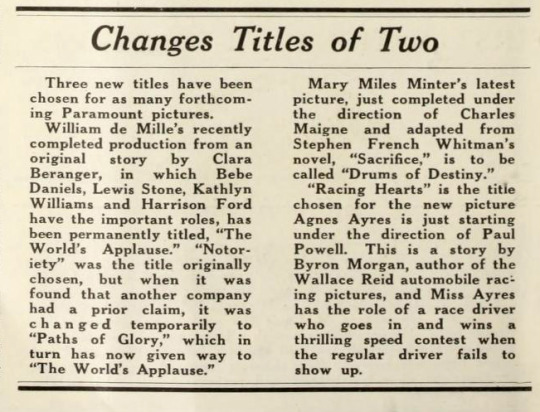
Moving Picture World, November 11, 1922
News from the Producers
Conducted by T.S. da Ponte
Changes Titles of Two
Three new titles have been chosen for as many forthcoming Paramount pictures.
William de Mille’s recently completed production from an original story by Clara Beranger, in which Bebe Daniels, Lewis Stone, Kathlyn Williams and Harrison Ford have the important roles, has been permanently titled, “The World’s Applause.” “Notoriety” was the title originally chosen, but when it was found that another company had a prior claim, it was changed temporarily to “Paths of Glory,” which in turn has now given way to “The World’s Applause.”
Mary Miles Minter's latest picture, just completed under the direction of Charles Maigne and adapted from Stephen French Whitman's novel, "Sacrifice," is to be called "Drums of Destiny."
"Racing Hearts" is the title chosen for the new picture Agnes Ayres is just starting under the direction of Paul Powell. This is a story by Byron Morgan, author of the Wallace Reid automobile racing pictures, and Miss Ayres has the role of a race driver who goes in and wins a thrilling speed contest when the regular driver fails to show up.
Both "Drums of Destiny" (titled "Drums of Fate" on release in 1923) and "Racing Hearts" are also lost films.


Exhibitor’s Herald, January 20, 1923
REVIEWS
BEBE DANIELS IN
WORLD’S APPLAUSE
(PARAMOUNT)
A fascinating story of the life of an actress who unwittingly becomes involved in a murder mystery which almost brings about her downfall professionally. Lavishly presented, very well acted and directed in William deMille’s best style. Length, 6,528 feet.
An original story by Clara Beranger provides Bebe Daniels, Lewis Stone, Kathlyn Williams, Adolph Menjou and others with a suitable vehicle in which to display their talents. There is good story interest for the most part, with good surprise value and considerable dramatic suspense in the contest of wits between the detectives and John Elliott and his sister.
Lewis Stone plays the role of Elliot and gives an unusually convincing and consistent characterization. The director, author and producer are to be congratulated upon securing Mr. Stone’s services for this part. Miss Daniels appears in the role of an actress who is a hound for publicity, and the moral of the story shows how ready the public is to condemn these children of the stage. Kathlyn Williams has the role of Elsa Townsend, wife of an artist in love with the little actress, who in a fit of jealousy kills her husband. A difficult role, but played with restraint and conviction. Adolphe Menjou is the artist. Bernice Frank was the maid; Mayme Kelso, secretary to the actress, and George Kuwa, valet to Townsend. James Neill was Elliot’s valet, while Brandon Hurst played James Crane, owner of a string of newspapers.
Corinne d’Alys, popular Broadway star, poses for Townsend while he paints her portrait. On the day he is to display the painting he gives a party at his studio. As the guests assemble, Mrs. Townsend comes to the studio, discovers a valuable pearl headdress which her husband is to give to Corinne, and the portrait of the actress. In a fit of jealousy she strikes him down and leaves the studio with her brother, John Elliot. The discovery of the dead artist throws suspicion upon the members of the party. Corinne telephones to her affianced husband Elliott and he succeeds in convincing the police that she is innocent. Crane takes a hand in the investigation, however, and dogs Elliott’s footsteps. A confession from Mrs. Townsend finally clears Elliott and the little actress, and she no longer seeks the world’s applause, but is content to settle down with John.
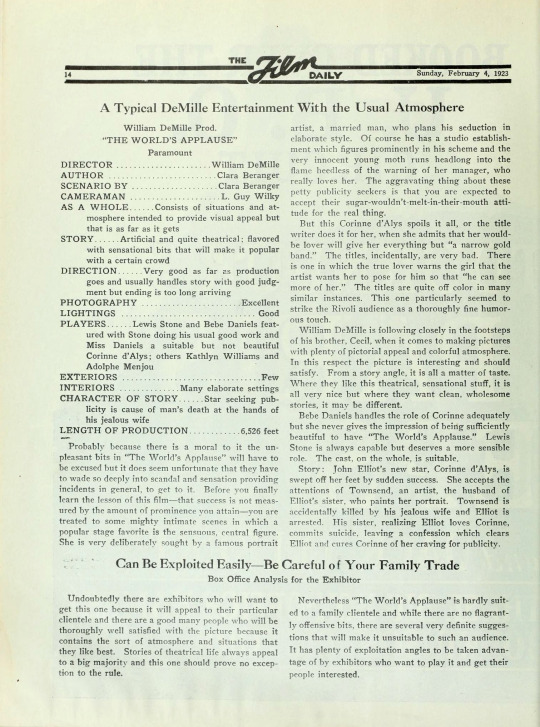
The Film Daily, February 2, 1923
A Typical DeMille Entertainment With the Usual Atmosphere
William DeMille Prod.
“THE WORLD’S APPLAUSE”
Paramount
DIRECTOR…William DeMille
AUTHOR…Clara Beranger
SCENARIO BY…Clara Beranger
CAMERAMAN…L. Guy Wilky
AS A WHOLE…Consists of situations and atmosphere intended to provide visual appeal but that is as far as it gets
STORY…Artificial and quite theatrical; flavored with sensational bits that will make it popular with a certain crowd
DIRECTION… Very good as far as production goes and usually handles story with good judgment but ending is too long arriving
PHOTOGRAPHY…Excellent
LIGHTINGS… Good
PLAYERS… Lewis Stone and Bebe Daniels featured with Stone doing his usual good work and Miss Daniels a suitable but not beautiful Corinne d’Alys; others Kathlyn Williams and Adolphe Menjou
EXTERIORS…Few
INTERIORS… Many elaborate settings
CHARACTER OF STORY…Star seeking publicity is cause of man’s death at the hands of his jealous wife
LENGTH OF PRODUCTION… 6,526 feet
Probably because there is a moral to it the unpleasant bits in “The World’s Applause” will have to be excused but it does seem unfortunate that they have to wade so deeply into scandal and sensation providing incidents in general, to get to it. Before you finally learn the lesson of this film—that success is not measured by the amount of prominence you attain—you are treated to some mighty intimate scenes in which a popular stage favorite is the sensuous, central figure. She is very deliberately sought by a famous portrait artist, a married man, who plans his seduction in elaborate style. Of course he has a studio establishment which figures prominently in his scheme and the very innocent young moth runs headlong into the flame heedless of the warning of her manager, who really loves her. The aggravating thing about these petty publicity seekers is that you are expected to accept their sugar-wouldn’t-melt-in-their-mouth attitude for the real thing.
But this Corinne d’Alys spoils it all, or the title writer does it for her, when she admits that her would-be lover will give her everything but “a narrow gold band.” The titles, incidentally, are very bad. There is one in which the true lover warns the girl that the artist wants her to pose for him so that “he can see more of her.” The titles are quite off color in many similar instances. This one particularly seemed to strike the Rivoli audience as a thoroughly fine humorous touch.
William DeMille is following closely in the footsteps of his brother, Cecil, when it comes to making pictures with plenty of pictorial appeal and colorful atmosphere. In this respect the picture is interesting and should satisfy. From a story angle, it is all a matter of taste. Where they like theatrical, sensational stuff, it is all very nice but where they want clean, wholesome stories, it may be different.
Bebe Daniels handles the role of Corinne adequately but she never gives the impression of being sufficiently beautiful to have “The World’s Applause.” Lewis Stone is always capable but deserves a more sensible role. The cast, on the whole, is suitable.
Story: John Elliot’s new star, Corinne d’Alys, is swept off her feet by sudden success. She accepts the attentions of Townsend, an artist, the husband of Elliot’s sister, who paints her portrait. Townsend is accidentally killed by his jealous wife and Elliot is arrested. His sister, realizing Elliot loves Corinne, commits suicide, leaving a confession which clears Elliot and cures Corinne of her craving for publicity.
One of those negative reviews that makes you want to watch a movie more, eh? Moralizing and misogyny on full display! Phew.
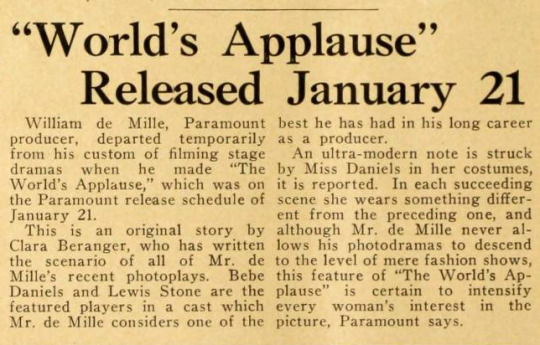
The Moving Picture World, February 1923
“World’s Applause” Released January 21
William de Mille, Paramount producer, departed temporarily from his custom of filming stage dramas when he made "The World's Applause," which was on the Paramount release schedule of January 21.
This is an original story by Clara Beranger, who has written the scenario of all of Mr. de
Mille's recent photoplays. Bebe Daniels and Lewis Stone are the featured players in a cast which Mr. de Mille considers one of the best he has had in his long career as a producer.
An ultra-modern note is struck by Miss Daniels in her costumes, it is reported. In each succeeding scene she wears something different from the preceding one, and although Mr. de Mille never allows his photodramas to descend to the level of mere fashion shows, this feature of "The World's Applause" is certain to intensify every woman's interest in the picture, Paramount says.

Variety, February 1923
WORLD'S APPLAUSE
Paramount picture presented by Adolph Zukor. William DeMille production, featuring Bebe Daniels, Lewis Stone and Kathlyn Williams in story by Clara Beranger.
At the Rivoli, New York, week of Jan. 28.
Corinne d'Alys..........Bebe Daniels
John Elliot........Lewis Stone
Elsa Townsend...Kathlyn Willams
Robert Townsend, her husband…Adolphe Menjou
James Crane...Brandon Hurst
Maid to Corinne...Bernice Frank
Secretary to Corinne.........Maym Kelso
Valet to Townsend..George Kuwa
Valet to Elliot......James Neill
“The World's Applause" is a screen treatise on theatrical publicity and exploitation with a twist that a certain theatrical personage's craving for newspaper "notices" and the desire to be the talk of the town boomerangs viciously when she is indirectly implicated in a murder mystery.
The theatrical personage is Corinne d'Alys (born Cora Daly), who has "taken the Rialto by storm," but who is counselled by her manager-lover (Lewis Stone) to cease her craving for the world's applause and deal seriously with her work. This is momentarily disparaged by her
with ensuing developments taking the audience rather interestingly through the usual five-reel span.
It starts with Robert Townsend, an artist who has "arrived" (Adolphe Menjou), becoming enamored with the favored and favorite footlights beauty and honoring her with painting her portrait for the annual Parisian exhibition. Townsend is married to the sister of John Elliot, the impresario, and a parallel situation develops of Townsend slighting his wife for Corinne, and
Townsend interposing himself between the actress and her suitor, Elliot.
At a studio party in Corinne's honor to which Townsend did not invite his wife, the latter enters
through the private studio door and, enraged at her husband's nonchalance, slashes the portrait and stabs the artist fatally. She telephones for her brother, who also enters unbeknown to the guests in the outer rooms. Both slip away, but not without being seen by a newspaper
publisher, whose testimony implicates Elliot, who shields his sister. Elliot is arrested on first degree murder charges, but is absolved when his sister confesses to Corinne. The sister runs away, and there is a suggestion she commits suicide via the watery route.
Not much to the story, but rather deftly handled by DeMille in his customary pretentious manner—never lavish but always in good taste. The captioning is pithy and bright, and such leaders as "the public always believes the worst about an actress" is good lay propaganda for the profession.
Miss Daniels sports a nobby collection of clothes to excellent advantage. Mr. Stone is a sincere opposite, who also has the ability of really acting when called upon. Miss Williams, too, accounted for herself handily.
The picture pleased at the Rivoli
Abel
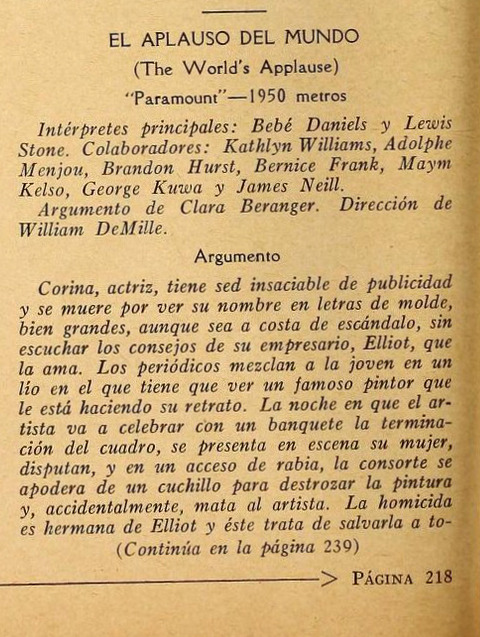
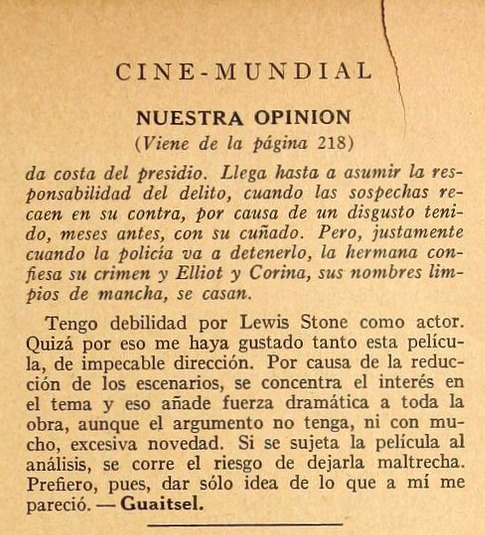
Cine-Mundial, April 1923 p. 218 & 239
EL APLAUSO DEL MUNDO
(The World’s Applause)
“Paramount” — 150 metros
Intérpretes principales: Bebé Daniels y Lewis Stone. Colaboradores: Kathryn Williams, Adolphe Menjou, Brandon Hurst, Bernice Frank, Maym Kelso, George Kuwa y James Neill.
Argumento de Clara Beranger. Dirección de William DeMille.
Argumento
Corina, actriz, tiene sed insaciable de publicidad y se muere por ver su nombre en letras de molde, bien grandes, aunque sea a costa de escándalo, sin escuchar los consejos de su empresario, Elliot, que la ama. Los periódicos mezclan a la joven en un lío en el que ver un famoso pintor que le está haciendo su retrato. La noche en que el artista va a celebrar con un banquete la terminación del cuadro, se presenta en escena su mujer, disputan, y en un acceso de rabia, la consorte se apodera de un cuchillo para destrozar la pintura y, accidentalmente, mata al artista. La homicida es hermana de Elliot y éste trata de salvarla a to-
(Continúa en la página 239)
NUESTRA OPINION
(Viene de la página 218)
da costa del presidio. Llega hasta a asumir la responsabilidad del delito, cuando las sospechas recaen en su contra, por causa de un disgusto tenido, meses antes, con su cuñado. Pero, justamente cuando la policía va a detenerlo, la hermana confiesa su crimen y Elliot y Corina, sus nombres limpios de mancha, se casan.
Tengo debilidad por Lewis Stone como actor. Quizá por eso me haya gustado tanto esta película, de impecable dirección. Por causa de la reducción de los escenarios, se concentra el interés en el tema y eso añade fuerza dramática a toda la obra, aunque el argumento no tenga, ni con mucho, excesiva novedad. Si se sujeta la película al análisis, se corre el riesgo de dejarla maltrecha. Prefiero, pues, dar sólo idea de lo que a mi me pareció. — Guaitsel.
Translation:
Lead actors: Bebe Daniels and Lewis Stone. Supporting actors: Kathlyn Williams, Adolphe Menjou, Brandon Hurst, Bernice Frank, Maym Kelso, George Kuwa and James Neill.
Scenario by Clara Beranger. Direction by WIlliam DeMille.
Scenario
Corina, an actress, has an insatiable thirst for publicity and would die to see her name in lights, even at the cost of scandal, without listening to the advice of her manager, Elliot, who loves her. The newspapers mix the young woman up in an imbroglio with a famous painter, who is painting her portrait. On the night that the artist is going to celebrate the completion of the painting with a banquet, his wife appears on the scene, they argue, and in a fit of rage, the wife seizes a knife to destroy the painting and, accidentally, kills the artist. The murderer is Elliot’s sister and he tries to save her from prison at all costs. He goes as far as assuming responsibility for the crime, when suspicion falls on him, due to a disagreement he had with his brother-in-law, months before. But, just as the police are going to arrest him, the sister confesses her crime and Elliot and Corina, their names clean, get married.
I have a soft spot for Lewis Stone as an actor. Maybe that’s why I liked this impeccably-directed film so much. Because of the limitation of settings, interest is concentrated on the theme and this adds dramatic force to the whole work, even though the scenario isn’t very excessively novel at all. If you subject the film to analysis, you run the risk of dealing damage to it. I prefer then to give only the outline of how it seemed to me. — Guaitsel.
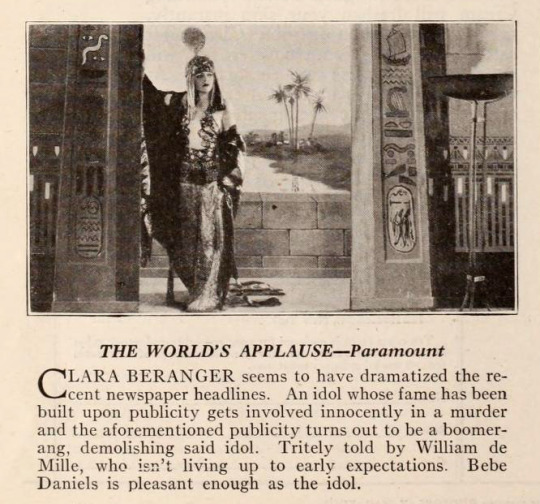
Photoplay, April 1923
THE WORLD’S APPLAUSE—Paramount
CLARA BERANGER seems to have dramatized the recent newspaper headlines. An idol whose fame has been built upon publicity gets involved innocently in a murder and the aforementioned publicity turns out to be a boomerang, demolishing said idol. Tritely told by William de Mille, who isn’t living up to early expectations. Bebe Daniels is pleasant enough as the idol.
Presumably, this writer is alluding to the Mary Miles Minter / William Desmond Taylor scandal from February of 1922. Kind of an interesting assumption given that, at the time, Minter was still under contract with Famous Player-Lasky, the same company that produced The World’s Applause.
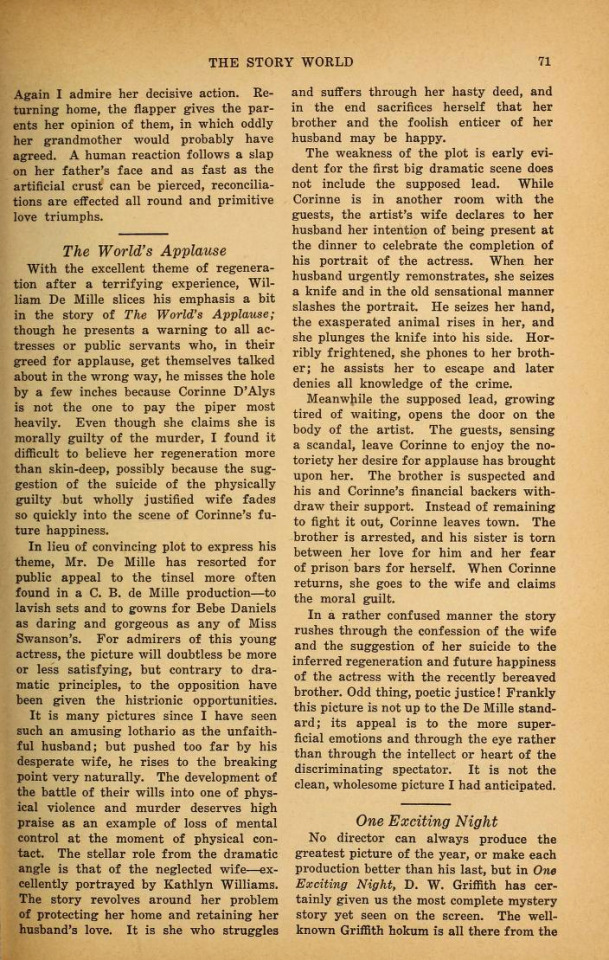
The Story World and Photodramatist, April 1923
The World's Applause
With the excellent theme of regeneration after a terrifying experience, William De Mille slices his emphasis a bit in the story of The World's Applause; though he presents a warning to all actresses or public servants who, in their greed for applause, get themselves talked about in the wrong way, he misses the hole by a few inches because Corinne D'Alys is not the one to pay the piper most heavily. Even though she claims she is morally guilty of the murder, I found it
difficult to believe her regeneration more than skin-deep, possibly because the suggestion of the suicide of the physically guilty but wholly justified wife fades so quickly into the scene of Corinne's future happiness.
In lieu of convincing plot to express his theme, Mr. De Mille has resorted for public appeal to the tinsel more often found in a C. B. de Mille production—to lavish sets and to gowns for Bebe Daniels as daring and gorgeous as any of Miss Swanson's. For admirers of this young actress, the picture will doubtless be more or less satisfying, but contrary to dramatic principles, to the opposition have been given the histrionic opportunities
It is many pictures since I have seen such an amusing lothario as the unfaithful husband; but pushed too far by his desperate wife, he rises to the breaking point very naturally. The development of the battle of their wills into one of physical violence and murder deserves high
praise as an example of loss of mental control at the moment of physical contact. The stellar role from the dramatic angle is that of the neglected wife—excellently portrayed by Kathlyn Williams. The story revolves around her problem of protecting her home and retaining her
husband's love. It is she who struggles and suffers through her hasty deed, and in the end sacrifices herself that her brother and the foolish enticer of her husband may be happy.
The weakness of the plot is early evident for the first big dramatic scene does not include the supposed lead. While Corinne is in another room with the guests, the artist's wife declares to her husband her intention of being present at the dinner to celebrate the completion of his portrait of the actress. When her husband urgently remonstrates, she seizes a knife and in the old sensational manner slashes the portrait. He seizes her hand, the exasperated animal rises in her, and she plunges the knife into his side. Horribly frightened, she phones to her brother; he assists her to escape and later denies all knowledge of the crime.
Meanwhile the supposed lead, growing tired of waiting, opens the door on the body of the artist. The guests, sensing a scandal, leave Corinne to enjoy the notoriety her desire for applause has brought upon her. The brother is suspected and his and Corinne's financial backers withdraw their support. Instead of remaining to fight it out, Corinne leaves town. The brother is arrested, and his sister is torn between her love for him and her fear of prison bars for herself. When Corinne returns, she goes to the wife and claims the moral guilt.
In a rather confused manner the story rushes through the confession of the wife and the suggestion of her suicide to the inferred regeneration and future happiness of the actress with the recently bereaved brother. Odd thing, poetic justice! Frankly this picture is not up to the De Mille standard; its appeal is to the more superficial emotions and through the eye rather than through the intellect or heart of the discriminating spectator. It is not the clean, wholesome picture I had anticipated.
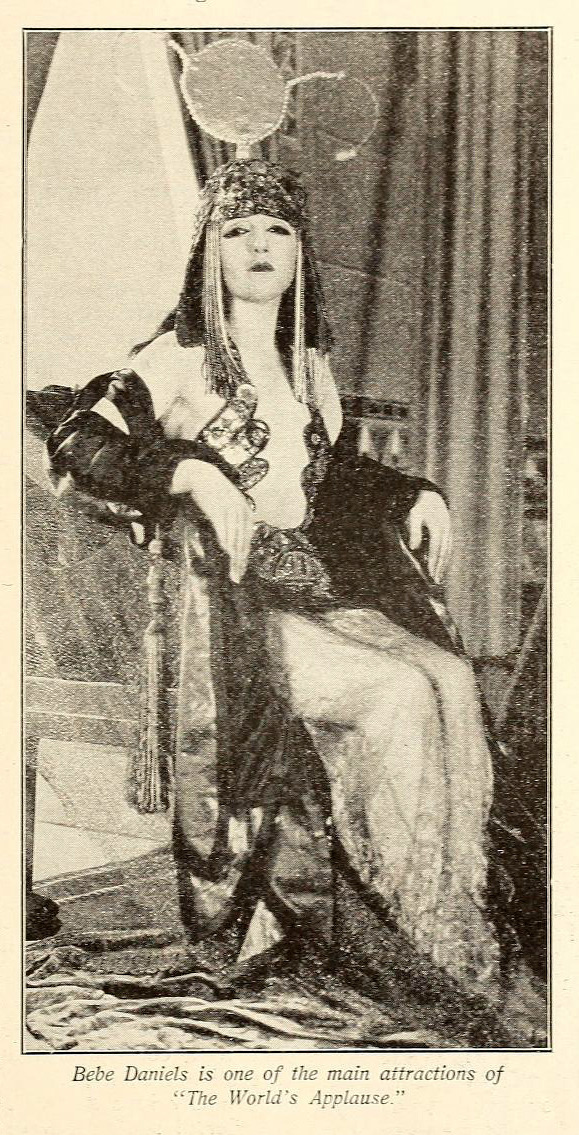
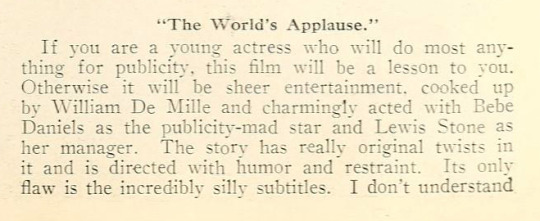

Picture Play Magazine, May 1923
The Screen in Review
“The World’s Applause.”
If you are a young actress who will do most anything for publicity, this film will be a lesson to you. Otherwise it will be sheer entertainment, cooked up by William De Mille and charmingly acted with Bebe Daniels as the publicity-mad star and Lewis Stone as her manager. The story has really original twists in it and is directed with humor and restraint. Its only flaw is the incredibly silly subtitles. I don’t understand how Mr. De Mille let them get by in one of his productions which always bear a certain imprint of good taste and sophistication.
#1920s#1923#The World's Applause#Bebe Daniels#William C. de Mille#lewis stone#silent era#silent movies#silent film#lost film#vamps#kathlyn williams#Clara Beranger#film magazine#movie magazine#Women Film Pioneers#classic movies#classic film#film history#Mary Miles Minter#lost but not forgotten
30 notes
·
View notes
Text

1908 Les robes de Paul Poiret by Paul Iribe vi (Sotheby's - 6May22 auction Karl Lagerfeld’s Estate Online III Lot 338). From their Web site; sized to screen 2477X2800.
#1908 fashion#1900s fashion#Belle Époque fashion#Edwardian fashion#Neo-Directoire style#head band#Poiret#Paul Iribe#Karl Lagerfeld#over-dress#V décolletage#bouquet#three-quarter length sleeves#over-skirt#close skirt
4 notes
·
View notes
Text

"Nijinsky à Mi-Corps, Tenant une Grappe de Raisin" par Adolf de Meyer et édité par Paul Iribe (1914) à l'exposition “Le Paris de la Modernité (1905-1925)” du Petit Palais, Musée des Beaux-Arts de la Ville de Paris, décembre 2023.
3 notes
·
View notes
Text
Paul Poiret Fashion Plate

from
Les robes de Paul Poiret
by Iribe, Paul, 1883-1935; Poiret, Paul
#paul poiret#historical fashion#historical dress#edwardian design#couture#designers#costume design#evening gown#dressing gown#internet archive
12 notes
·
View notes
Text


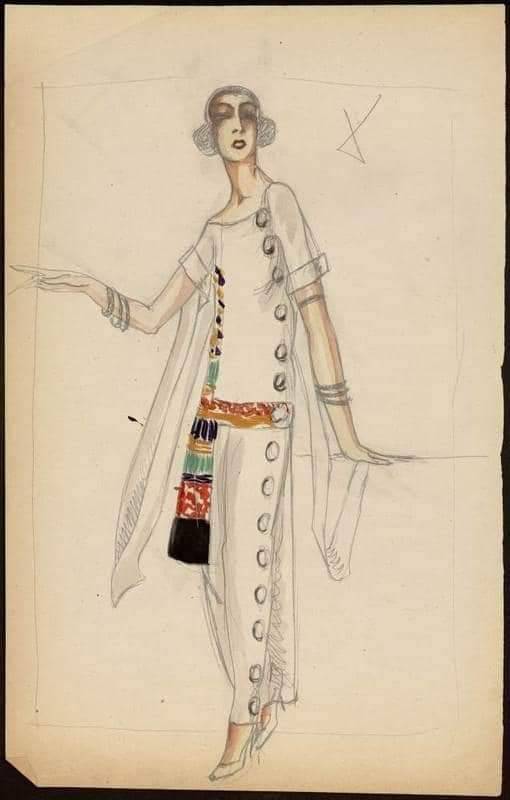

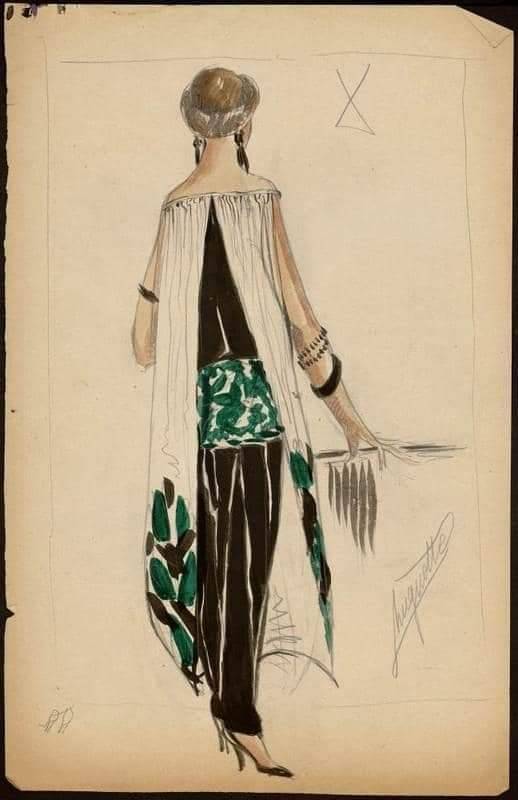
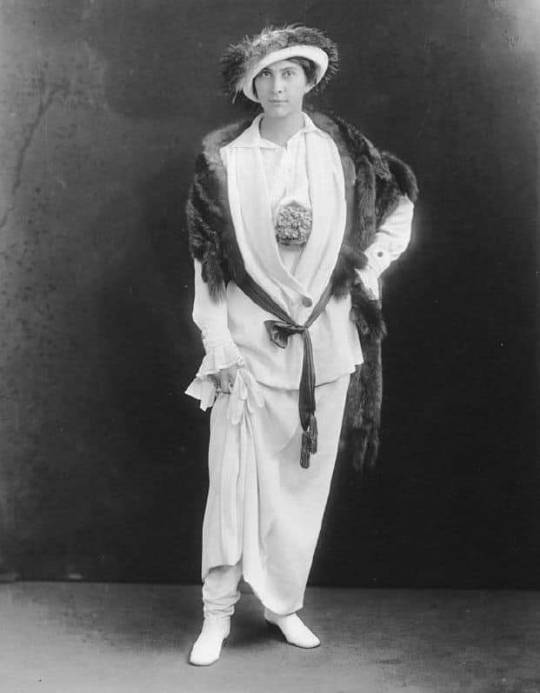

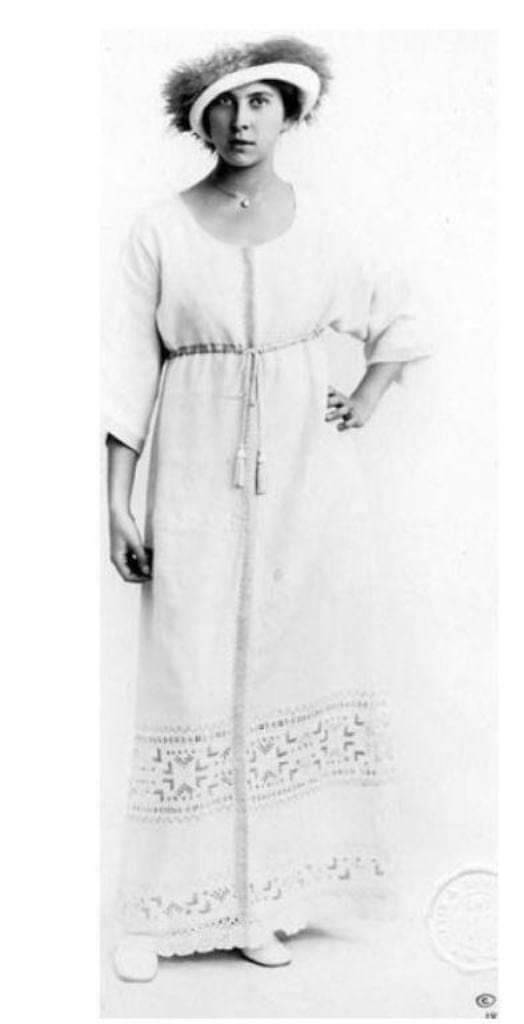


"Paul Poiret, the self proclaimed, King of Fashion.
The story of Paul Poiret is one of a working class son, who used his natural charisma to gain entry into some of the most exclusive ateliers in Paris and eventually became one of the twentieth century’s great couturiers. But it’s also a cautionary tale about a man who refused to adapt to changing times and styles after WWII due to his arrogance and finally ended penniless and bitter, his once-great label long forgotten.
Paul Poiret is born 20 April, 1879 as the son of a cloth merchant, in Paris’s working-class quartier of Les Halles. As a young boy he is sent to apprentice with an umbrella manufacturer, where he gathers “the scraps of silk left over after the umbrella patterns had been cut,” and uses them “to dress a little wooden doll that his sister . . . had given him.”
Still a teenager, Poiret takes his sketches to Madeleine Chéruit, a prominent dressmaker, who purchases a dozen from him. He continues to sell his drawings to major Parisian couture houses, till he is hired by Jacques Doucet, one of the capital’s most prominent couturiers. Poiret is only nineteen years old at the time. Beginning as a junior assistant, he is soon promoted to head of the tailoring department. His debut design for Doucet, a red wool cloak with a reverse gray crepe-de-chine lining, receives 400 orders from customers.
After two years of mandatory military service (1914-1918), he returns to Paris and is hired by House of Worth, once founded by Charles Worth, but now taken over by his sons. Instead of working on the luxurious eveningwear the House is famous for, Poiret is put in charge of the less glamorous and more practical items. Gaston Worth, the business manager, referred to Poiret’s division as the “Department of Fried Potatoes.” His ideas and designs are not appreciated by the clients. One of his “fried potatoes,” a cloak made from black wool and cut along straight lines like the kimono, proved too simple for one of Worth’s royal clients, the Russian princess Bariatinsky, who on seeing it cried, “What horror; with us, when there are low fellows who run after our sledges and annoy us, we have their heads cut off, and we put them in sacks just like that.”
At twenty-four (Poiret has a tireless self-confidence, despite his experiences at the House of Worth) he breaks out on his own and after borrowing funds from his mother, opens his own shop on Rue Auber. Its flashy window displays attract attention and he makes his name with the controversial kimono coat. Looking to both antique and regional dress types, most notably to the Greek chiton, the Japanese kimono, and the North African and Middle Eastern caftan, Poiret advocated fashions cut along straight lines and constructed of rectangles.
In 1905 Poiret marries childhood friend Denise, with whom he’ll go on to have five children. “She was extremely simple,” he later will say, “and all those who have admired her since I made her my wife would certainly not have chosen her in the state in which I found her.” Denise Poiret will eventually become his artistic director as well as muse, wearing his designs as they travel around Europe together and winning a reputation as a trendsetter. (A fact her husband will later take credit for: “I had a designer’s eye, and I saw her hidden graces.”)
Years later, Denise Poiret is described as:
“the woman who had inspired the feminine silhouette of this century”
Poiret’s process of design through draping is the source of fashion’s modern forms. It introduced clothing that hung from the shoulders and facilitated a multiplicity of possibilities. Poiret exploited its fullest potential by launching, in quick succession, a series of designs that were startling in their simplicity and originality. From 1906 to 1911, he presented garments that promoted a high-waisted Directoire Revival silhouette. Different versions appeared in two limited-edition albums, Paul Iribe’s Les robes de Paul Poiret (1908) and Georges Lepape’s Les choses de Paul Poiret (1911).
Every decade has its fortune-teller, a designer who, above all others, is able to divine and define the desires of women. In the 1910s, this oracle of fashion was Paul Poiret, known in America as “The King of Fashion.” In Paris, he was simply Le Magnifique, after Süleyman the Magnificent, a suitable nickname for a couturier who, alongside the great influence of Sergei Diaghilev’s Ballets Russes, employed the language of orientalism to develop the romantic and theatrical possibilities of clothing. Like his artistic confrere Léon Bakst, Poiret’s exoticized tendencies were expressed through his use of vivid color coordinations and mysterious silhouettes such as his iconic “lampshade” tunic, “Kymono” coat and his “harem” trousers, or pantaloons. However, these orientalist fantasies (or, rather, fantasies of the Orient) have served to decline from Poiret’s more enduring innovations, namely his technical and marketing achievements. Poiret effectively established the canon of modern dress and developed the blueprint of the modern fashion industry. Such was his vision that Poiret not only changed the course of costume history but also steered it in the direction of modern design history..
Anecdote: Lady Asquith, wife of British Prime Minister H. H. Asquith, invites Poiret to show gowns at 10 Downing Street. Stories of half-nude models running amok at the prime minister’s residence cause a furor in the press and the resulting scandal almost forces Asquith to resign...
Paul Poiret on Tour with his Collections: Historians consider Poiret the first haute couturier to have taken his collections on tour in Europe and America. He visited Berlin in 1910, and the next year went on a six-week trek (in a chauffeured car) to Moscow, St. Petersburg, Warsaw, Vienna, Frankfurt, Berlin, and Bucharest—where he was arrested for not having a proper permit. Poiret’s arrival in New York in 1913 was prefaced by an open letter from John Cardinal Farley warning against the temptations offered by “the demon fashion.”
https://agnautacouture.com/2014/04/06/paul-poiret-le-magnifique-part-2/
https://agnautacouture.com/2014/05/11/paul-poiret-pictures-of-garments-accessoires-part-3/".
> Philip Pradere > Vintage Fashion uncovered
9 notes
·
View notes




